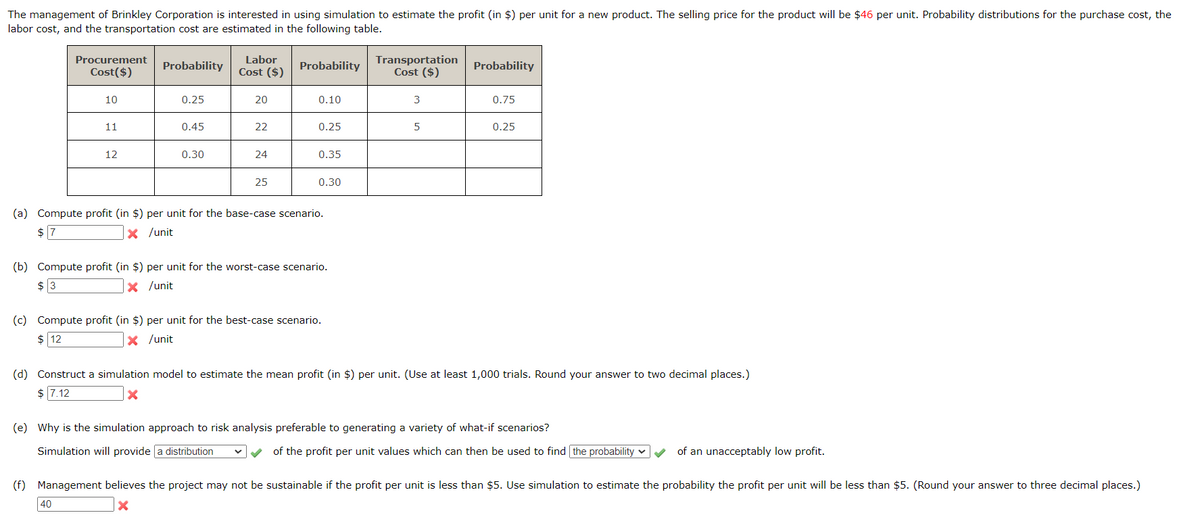The management of Brinkley Corporation is interested in using simulation to estimate the profit (in $) per unit for a new product. The selling price for the product will be $46 per unit. Probability distributions for the purchase cost, the labor cost, and the transportation cost are estimated in the following table. Procurement Cost($) Probability Labor Cost ($) Probability Transportation Cost ($) Probability 10 0.25 20 0.10 3 0.75 11 0.45 22 0.25 5 0.25 12 0.30 24 0.35 25 0.30 (a) Compute profit (in $) per unit for the base-case scenario. x /unit $ 7 (b) Compute profit (in $) per unit for the worst-case scenario. x /unit $ 3 (c) Compute profit (in $) per unit for the best-case scenario. $ 12 ✓ /unit (d) Construct a simulation model to estimate the mean profit (in $) per unit. (Use at least 1,000 trials. Round your answer to two decimal places.) $ 7.12 (e) Why is the simulation approach to risk analysis preferable to generating a variety of what-if scenarios? Simulation will provide a distribution (f) 40 of the profit per unit values which can then be used to find the probability of an unacceptably low profit. Management believes the project may not be sustainable if the profit per unit is less than $5. Use simulation to estimate the probability the profit per unit will be less than $5. (Round your answer to three decimal places.)
The management of Brinkley Corporation is interested in using simulation to estimate the profit (in $) per unit for a new product. The selling price for the product will be $46 per unit. Probability distributions for the purchase cost, the labor cost, and the transportation cost are estimated in the following table. Procurement Cost($) Probability Labor Cost ($) Probability Transportation Cost ($) Probability 10 0.25 20 0.10 3 0.75 11 0.45 22 0.25 5 0.25 12 0.30 24 0.35 25 0.30 (a) Compute profit (in $) per unit for the base-case scenario. x /unit $ 7 (b) Compute profit (in $) per unit for the worst-case scenario. x /unit $ 3 (c) Compute profit (in $) per unit for the best-case scenario. $ 12 ✓ /unit (d) Construct a simulation model to estimate the mean profit (in $) per unit. (Use at least 1,000 trials. Round your answer to two decimal places.) $ 7.12 (e) Why is the simulation approach to risk analysis preferable to generating a variety of what-if scenarios? Simulation will provide a distribution (f) 40 of the profit per unit values which can then be used to find the probability of an unacceptably low profit. Management believes the project may not be sustainable if the profit per unit is less than $5. Use simulation to estimate the probability the profit per unit will be less than $5. (Round your answer to three decimal places.)
Practical Management Science
6th Edition
ISBN:9781337406659
Author:WINSTON, Wayne L.
Publisher:WINSTON, Wayne L.
Chapter11: Simulation Models
Section: Chapter Questions
Problem 56P: A common decision is whether a company should buy equipment and produce a product in house or...
Related questions
Question
100%

Transcribed Image Text:The management of Brinkley Corporation is interested in using simulation to estimate the profit (in $) per unit for a new product. The selling price for the product will be $46 per unit. Probability distributions for the purchase cost, the
labor cost, and the transportation cost are estimated in the following table.
Procurement
Cost($)
Probability
Labor
Cost ($)
Probability
Transportation
Cost ($)
Probability
10
0.25
20
0.10
3
0.75
11
0.45
22
0.25
5
0.25
12
0.30
24
0.35
25
0.30
(a) Compute profit (in $) per unit for the base-case scenario.
x /unit
$ 7
(b) Compute profit (in $) per unit for the worst-case scenario.
x /unit
$ 3
(c) Compute profit (in $) per unit for the best-case scenario.
$ 12
✓ /unit
(d) Construct a simulation model to estimate the mean profit (in $) per unit. (Use at least 1,000 trials. Round your answer to two decimal places.)
$ 7.12
(e) Why is the simulation approach to risk analysis preferable to generating a variety of what-if scenarios?
Simulation will provide a distribution
(f)
40
of the profit per unit values which can then be used to find the probability
of an unacceptably low profit.
Management believes the project may not be sustainable if the profit per unit is less than $5. Use simulation to estimate the probability the profit per unit will be less than $5. (Round your answer to three decimal places.)
Expert Solution
This question has been solved!
Explore an expertly crafted, step-by-step solution for a thorough understanding of key concepts.
This is a popular solution!
Trending now
This is a popular solution!
Step by step
Solved in 1 steps

Recommended textbooks for you

Practical Management Science
Operations Management
ISBN:
9781337406659
Author:
WINSTON, Wayne L.
Publisher:
Cengage,

Practical Management Science
Operations Management
ISBN:
9781337406659
Author:
WINSTON, Wayne L.
Publisher:
Cengage,